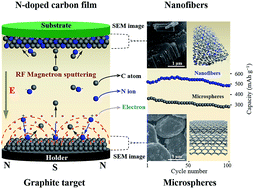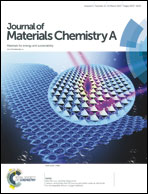Freestanding highly defect nitrogen-enriched carbon nanofibers for lithium ion battery thin-film anodes†
Abstract
To transform lithium ion batteries into large-scale energy storage technologies, high energy/power densities and long cycling life of carbon-based anodes must be achieved. This requires revolutionary design of the anode's architecture that can facilitate fast electronic and ionic transport, and accommodate the electrode structural instability. Here we report a thin-film electrode design and demonstrate its use in flexible, and large-area carbon-based anode assemblies. The fabrication of electrodes is realized by sputtering a graphite target in the high-purity nitrogen atmosphere, then highly defect nitrogen-doped carbon nanofibers are deposited vertically onto copper substrates with a thin film configuration. The high-defect nitrogen-doping enhances the lithium storage and transport, the orientation growth mechanism improves the charge transfer, and the compact configuration makes high tap density possible. As a result, the thin films exhibit a high specific capacity of ∼500 mA h g−1, namely a volume capacity of ∼100 mA h cm−3. They also exhibit stable cycle performance (400 mA h g−1 after 200 cycles) and good rate capability (450 mA h g−1 at 1 A g−1 rate). This work opens up a new carbon-based anode design by using sputtering technology for effectively incorporating high content nitrogen into carbon matrices. Such electrode architecture significantly improves the electrochemical performance of carbon-based materials.


 Please wait while we load your content...
Please wait while we load your content...